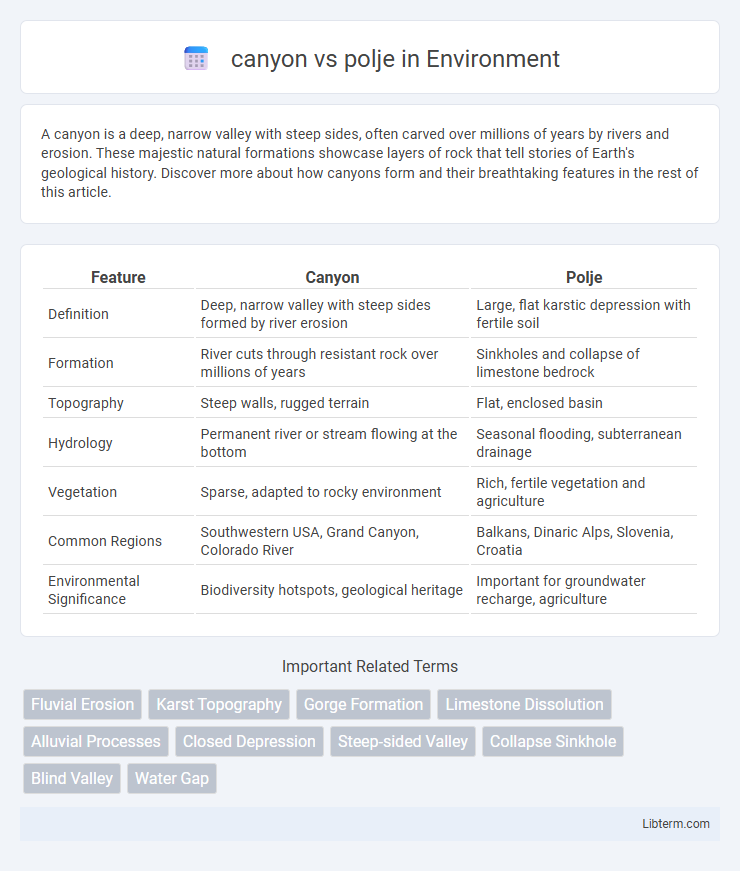A canyon is a deep, narrow valley with steep sides, often carved over millions of years by rivers and erosion. These majestic natural formations showcase layers of rock that tell stories of Earth's geological history. Discover more about how canyons form and their breathtaking features in the rest of this article.
Table of Comparison
| Feature | Canyon | Polje |
|---|---|---|
| Definition | Deep, narrow valley with steep sides formed by river erosion | Large, flat karstic depression with fertile soil |
| Formation | River cuts through resistant rock over millions of years | Sinkholes and collapse of limestone bedrock |
| Topography | Steep walls, rugged terrain | Flat, enclosed basin |
| Hydrology | Permanent river or stream flowing at the bottom | Seasonal flooding, subterranean drainage |
| Vegetation | Sparse, adapted to rocky environment | Rich, fertile vegetation and agriculture |
| Common Regions | Southwestern USA, Grand Canyon, Colorado River | Balkans, Dinaric Alps, Slovenia, Croatia |
| Environmental Significance | Biodiversity hotspots, geological heritage | Important for groundwater recharge, agriculture |
Introduction to Canyons and Poljes
Canyons are deep, narrow valleys with steep sides, formed primarily by river erosion over millions of years, often found in arid or semi-arid regions. Poljes, characteristic of karst landscapes, are large, flat-floored depressions with steep walls, created by the dissolution of soluble rocks like limestone. Both landforms illustrate distinct geological processes: canyons shaped by fluvial erosion and poljes by karstic dissolution and subsidence.
Defining Canyons: Features and Formation
Canyons are deep, narrow valleys with steep rocky walls, formed primarily by the erosive activity of rivers over millions of years cutting through resistant bedrock. These landforms often exhibit V-shaped cross-sections, showcasing exposed stratified rock layers and significant vertical relief. Unlike poljes, which are large, flat-floored karstic basins with soluble rock, canyons represent dramatic incisions shaped by fluvial erosion in diverse geological settings.
Understanding Poljes: Characteristics and Origins
Poljes are large, flat-floored depressions in karst landscapes, typically enclosed by steep limestone walls, formed through complex processes of dissolution and subsidence. These expansive basins often feature fertile soils and intermittent lakes due to seasonal flooding, distinguishing them from narrow, deep canyons created primarily by river erosion. Understanding poljes involves recognizing their formation through the collapse of underground cavities and the accumulation of sediment, which contrasts with the linear incision characteristic of canyon development.
Geological Processes Behind Canyons
Canyons form primarily through fluvial erosion as rivers cut deep into the earth's crust over millions of years, carving V-shaped valleys and exposing layered rock formations. The geological processes involve mechanical weathering, sediment transport, and tectonic uplift, which enhance the river's erosive power and deepen the canyon. Unlike poljes, which develop from karst processes involving the dissolution of soluble rocks like limestone, canyons result from persistent river incision through resistant bedrock.
How Poljes Develop: Karst Processes Explained
Poljes develop through karst processes involving the dissolution of soluble limestone or dolomite bedrock, creating large, flat-floored depressions within karst landscapes. Over time, underground water enlarges joints and faults, collapsing cave systems and forming broad basins with temporary or permanent water bodies. These natural depressions contrast sharply with narrow, steep-walled canyons carved primarily by river erosion.
Key Differences: Canyon vs. Polje
A canyon is a deep, narrow valley with steep, rocky walls formed by river erosion, often found in arid or semi-arid regions. A polje is a large, flat-floored depression in karst landscapes, created by the dissolution of limestone and characterized by periodic flooding and fertile soils. Unlike canyons, poljes are typically expansive and surrounded by limestone hills, representing distinct geological and hydrological processes.
Ecological and Environmental Significance
Canyons create unique microhabitats that support diverse plant and animal species adapted to steep, rocky environments and variable water availability. Poljes, characterized by their fertile flat floors and periodic flooding, serve as crucial groundwater recharge zones and support agricultural biodiversity through nutrient-rich soils. Both landforms play vital roles in regional hydrology and biodiversity conservation but differ in their ecological dynamics due to contrasting topography and water regimes.
Notable Examples of Canyons Worldwide
The Grand Canyon in the United States and the Fish River Canyon in Namibia stand as two of the most notable examples of canyons worldwide, showcasing vast, steep-sided gorges carved by rivers over millions of years. These geological formations demonstrate the power of erosion in arid and semi-arid environments, with the Grand Canyon featuring layered sedimentary rock that reveals Earth's geological history. In contrast, poljes are large, flat-floored depressions found primarily in karst regions, such as the Livno Polje in Bosnia and Herzegovina, differing significantly in formation and appearance from deep, narrow canyons.
Famous Poljes Around the Globe
Famous poljes such as the Livno Polje in Bosnia and Herzegovina, the Popovo Polje also in Bosnia, and the Gracanica Polje are expansive karst fields characterized by flat floors and intermittent lakes, contrasting with narrow, steep-walled canyons formed by river erosion. The Dinaric Alps region hosts some of the largest and most studied poljes, featuring fertile soils and unique hydrological systems crucial for agriculture and biodiversity. Poljes like the Sinj Polje in Croatia showcase the geological and cultural significance of karst landscapes worldwide, offering distinctive environments compared to the dramatic vertical relief of canyons.
Conclusion: Choosing Between Canyon and Polje
Choosing between a canyon and a polje depends on geological features and landscape formation. Canyons are deep, narrow valleys with steep rocky walls formed primarily by river erosion, ideal for dramatic terrain and rugged ecosystems. Poljes are large, flat-floored karst depressions with fertile soil, suitable for agriculture and seasonal water drainage, reflecting different environmental and land-use priorities.
canyon Infographic

 libterm.com
libterm.com